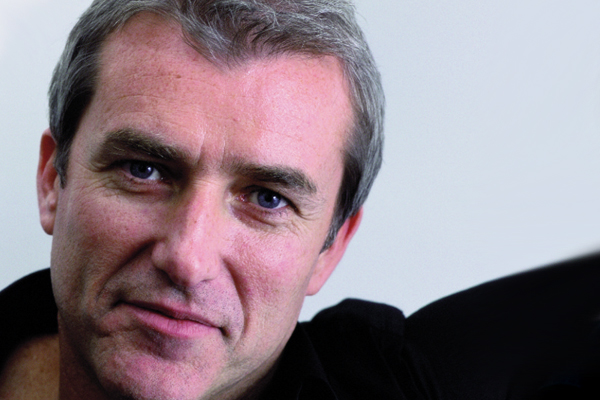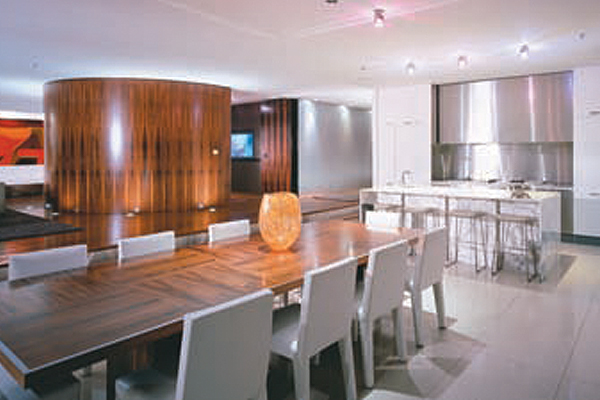He still isn’t forty years of age, yet Andrew Parr’s achievements already outstrip those of many another career. He is best known for his elegant and exquisitely detailed interiors. But he has also designed furniture and, with his restless creativity, there may be more careers still to come.

April 7th, 2014
After establishing SJB Interiors ten years ago, founder and principal Andrew Parr has produced an extensive body of innovative, high-profile design projects, won a string of prestigious awards and, in the process, become one of Australia’s leading interior designers.
You could say he was born a designer. “I had a big interest in the built environment, even as a young kid,” he says. “Instinctively, I was just drawn to it.” He still has the “books and books and scrapbooks filled with drawings of dwellings, houses on hills,” that he began when he was only five or six years of age. “It was quite an exciting period in the seventies. I grew up in a new, developing area [of Melbourne], with a lot of building activity going on around me.” The family moved relatively often, too, so there was always a new house to think about.
Still not in his teens, he was attracted to images of an early Glenn Murcutt house he saw in a magazine “a beautiful, black steel modernist house. That really started to drive me to investigate modernism and all the Case Study stuff, (housing prototypes designed by American modernist architects from 1945-66 in the Los Angeles area).”
In Melbourne housing design at the time, he says, “there were two styles going on: either mock-colonial ranch house, or your rustic contemporary, which basically meant slate floor, exposed cedar ceilings and exposed brick walls. Then, in my own investigation I saw houses – exposed steel, glass, brick floors and whitewashed walls – that took it to another level of simplicity.” Parr was instantly drawn to the clean lines, refinement and drama of these houses. “There were a lot of them in Ivanhoe. Then I realised they were by serious architects.” He had accidentally discovered modernism and was intuitively drawn to it.
Armed with this information, at the age of 16, he designed the next new home for his family. Built by a family friend, Parr describes it as “an off-white rendered house, simple and plain, with a silver birch jungle at the front and a gravel drive. The front was like a true modernist house, like a fortress – all garages and you enter through a hole in the middle, then through a series of courtyards. It was all glazed at the rear and overlooked this great view of the Dandenong Ranges.”
The house was being built while Parr studied for his HSC. Initially he’d been aiming for architecture. But without achieving the science pre-requisites, he opted for interior design instead. “I was more on the fine art side anyway,” he says, “and now the overlap is so hard to define.” These days he still designs buildings occasionally – not large commercial buildings, but residential. He designed his own house in St Kilda, which was much publicised and awarded.
In 1987, fresh from the Interior Design School at RMIT, Parr joined Synman Justin Bialek Architects and was immediately designing office fitouts and residential work. One of his first major projects was Smorgon Headquarters, a complex and demanding commission involving, in effect, 20 different clients and the opportunity to incorporate significant artworks. “You learn a lot when you’re thrown in like that.” By 1994, instead of starting up on his own, he established SJB Interiors as an independent entity within the Synman Justin Bialek group. The work expanded from commercial fitouts to advertising agencies – “the groovier end” of the business – and soon included projects at Crown Casino, which prior to its opening in 1997, had “engulfed everyone in Melbourne” in the design profession. The Crown Casino project proved yet another extraordinary learning curve. Parr recalls it as two years full time involvement, weekends included – presenting and reviewing drawings, responding to re-briefings overnight, re-designing and re-presenting. “It was like paying your ultimate dues,” he says, acknowledging that the knowledge base, contacts and experience that resulted have been invaluable.
Crown Casino was his first taste of hospitality work, which he now regards, along with retail, as interior design’s most creative arena. “Firstly, because it’s got to be at the forefront, it can’t be a repeat of something else and succeed.” He enjoys the creativity this demands and finds the opportunities, with their focus on atmosphere and ambience, more enjoyable and the results more rewarding, particularly because as public spaces they are far more visible than private commercial work.
The Crown Casino project led to commissions in Sydney, initially in creating the notable restaurants, MG Garage and Fuel. A string of other prestigious projects followed, along with a swag of awards and the inevitable expansion of the company, which now has offices in both Sydney and Melbourne and employs 25 staff. While SJB Interiors still collaborates with architects from the parent-company, over 80% of the firm’s work is now independently generated. Meanwhile, Parr himself is recognised as one of Australia’s foremost interior designers, with a prolific output of prestigious projects to his name.

Fitzroy Street Penthouse, designed by Andrew Parr.
Wary of architects or designers who impose an iconic formula on a project regardless, Parr likes to see the client’s needs and persona reflected in the result, particularly in regard to residential work. “At the end of the day, you’re not designing it for yourself,” he says. In hospitality and retail areas, where the need to create interiors that are original and distinctive is paramount, he believes the distinguishing influence of the client can contribute to that differentiation.
For his part, Parr has achieved that singularity across a broad diversity of projects, produced in a style which he describes as a personal interpretation of contemporary minimalism, and through which he aims to blend luxury and accessibility without pretension. He enjoys working with the fabric of an old building, preserving original elements and contrasting them with contemporary aspects. He sees a consistent thread through his work, a signature style, expressed through colour and mood, texture and light, and also in spatial planning. The modernist ethic underpins the planning, which is clean and simple, with functionality as a priority.
“I always work out the main feature, the essence of the space, then let the other [details] recede.“ In the course of this, Parr says, a layering process occurs. The results are varied and contemporary. He is far too savvy not to be aligned with current thinking. “You can’t help being part of, or influenced by the movement [of the time],“ he says. “When I finished school it was Post-Modernism, almost Memphis. At the moment it’s Neo-Baroque. The chandelier thing that has been going on for the last five years is really over [but] it’ll still keep happening while people like the hoteliers promote it as The Thing.“
Top left: ‘Club’ Armchair from Luxe Range
Top right: Dining Chair from Luxe Range
Bottom: ‘Bench’ from Luxe Range
Maintaining the faith with Modernism, Parr says some of the best houses he’s ever seen were designed by Guildford Bell. “A serious modernist of the sixties, [Bell designed] fantastic houses – a lot of them in Melbourne, only one or two in Sydney.” He also admires the Case Study Houses, United States, but is not so enamoured with contemporary modernists, believing they’ve made little progress since then. In the furniture and interior design area, however, he is enthusiastic about the celebrated French designer, Christian Liagre, “who basically started the whole Asian contemporary look. He was influenced by these cultures and refined the forms to a beautiful point. I don’t think anyone does it better than him. I’d been collecting his editorial in my favourite magazines even before he was famous.”
From the outset, Parr has designed furniture and light fittings for his projects as and when required, although these have never been taken into production. He regards a light fitting “as one of those magical things in an interior. Whether it be a floor lamp or a pendant, it does sparkle. It is magical. It is sculpture in the space.” His use of “interesting colour” is another hallmark of his approach.
He has a preference for colours that are muted or altered a shade or two from the primary and often favours warm, yellow-based colours. He likes to counterpoint the energy of these colours with cool, dull or neutral materials – concrete, render, black floorboards, dark carpet or slate. Interestingly, in response to the differences in culture and environment between Sydney and Melbourne, the work he has produced in each city involves the use of quite different colour palettes. “Sydney, for me, is an L.A. style city, so I explore fresher colours, white and yellow. I haven’t used a lot of dark, saturated colours in Sydney, whereas I will use them quite a lot [in Melbourne] particularly in residential work.”
Often the brief Parr receives from a client developing a bar or restaurant will steer him only towards a target demographic. It is then up to the firm to interpret the mindset of the sector, and current trends, to come up with an innovative interior scheme that will excite and attract the market. Given that distinctive character, if not originality, is mandatory, where do his designs come from? “Ideas come from experiences,” he says. “Everyone’s got an encyclopaedia of experiences in their head, which are almost catalogued.” Trawling for ideas he also reads stacks of magazines and goes to the Furniture Fair in Milan each year. “You get invigorated by the Satellite exhibitions; they take you out of your normal thinking, make you push it further.”
After taking a new brief, Parr lets it settle for a while. “I might go on a reading session for a week, then put the magazines away. I avoid looking at them when I’m designing because they inform [me] too much. But what I’ve seen might inspire other [thoughts], and as I start drawing, the ideas come out. I draw very quickly, it’s very loose, but descriptive enough to get my ideas over.” Using Yoken markers and pencil on tracing paper “it becomes like a great watercolour.” From rough floor plans he goes straight to perspectives, in which he composes the space and captures the mood. “It’s pretty much an explosion. I’ll have a lot of ideas about how it goes together but the space hasn’t been nailed until I’ve drawn it.”
On major projects staff will work as a collective, sharing or combining ideas. “You can’t be the master of every idea,” he says. “Sometimes your brain’s too saturated, but that’s what they’re there for as well.”
While he claims he’s becoming more cautious as he gets older, he adds, “I’ve been pretty gung-ho for quite a long time. I’ve never had a problem with going and getting new work, dealing with new people.” The firm grows “through existing contacts, word of mouth, meeting new people,” with whom he works to build up a relationship. While SJB Interiors works mainly in Sydney and Melbourne, commissions are now spread much further afield. “We’re working in Queensland. We’re working in Berlin,” he says. Not that Parr wants to leave Australia, on the contrary. “Technology has really aided design, in that you’re not disadvantaged working in any place of a reasonable size. You can [work] anywhere in the world – you only have to go there maybe five times in the process of a big job.”
Major projects where he can express a creative edge remain the drawcard for Parr, along with the satisfaction of getting it right. “I still have that really great adrenaline rush and euphoria when I go into a space that I know has worked. That’s what still drives me. Otherwise it’s all too hard, really. You get a sense of when a job’s right, you walk in and it feels good.”
Portrait by Anthony Browell.
Andrew Parr was featured as a Luminary in issue #18 of Indesign, August 2004.
INDESIGN is on instagram
Follow @indesignlive
A searchable and comprehensive guide for specifying leading products and their suppliers
Keep up to date with the latest and greatest from our industry BFF's!

For Aidan Mawhinney, the secret ingredient to Living Edge’s success “comes down to people, product and place.” As the brand celebrates a significant 25-year milestone, it’s that commitment to authentic, sustainable design – and the people behind it all – that continues to anchor its legacy.

A curated exhibition in Frederiksstaden captures the spirit of Australian design

Congratulations to Kerstin Thompson, 2023 recipient of the Australian Institute of Architects’ Gold Medal. We revisit Kerstin’s many accomplishments, among them being named an INDESIGN Luminary.

As NGV’s top design curators, Simone LeAmon and Ewan McEoin have big dreams for the design sector. And they’re coming at it with energy and ambition.
The internet never sleeps! Here's the stuff you might have missed

Sydney Open invites the public to explore over 55 buildings, spaces and new additions to the skyline, with a newly released Talks & Tours program offering direct access to the architects behind Bundarra and Pier Pavilion.

McIldowie Partners, in association with Joost Bakker, has been awarded The Learning Space at the INDE.Awards 2025. Their project, Woodleigh Regenerative Futures Studio, redefines the educational environment as a living ecosystem that nurtures sustainability, innovation, and community.

Architectus’ new headquarters for Q-CTRL addresses complex technical requirements while creating an enjoyable place to work.

MillerKnoll reimagines the convention of dinner table interactions by plating up a future-forward menu of sustainable design conversation starters as part of the inspiring “Conversations for a Better World” event series.